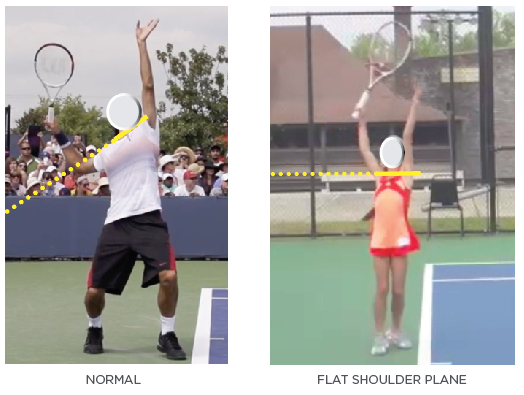Flat Shoulder Plane
Sun Apr 21, 2019 by Dr. Greg Rose
A Flat Shoulder Plane describes the amount of shoulder tilt (side bend) an athlete has once they get into the trophy position. Normally, an athlete moves into a large amount of back side bend as they approach the trophy position. This side bend helps load the spine, improves contact consistency, as well as creates power in the serve. If the athlete has a reduced amount of side bend in the trophy position, we call this a Flat Shoulder Plane. As a result the player will usually make compensations with the body and hands to square the racquet.
The easiest way to diagnose a Flat Shoulder Plane is from the side-on view. Draw a line from the top of the back shoulder to the top of the front shoulder. If you were to imagine that line extending down to the ground, it should hit the floor, anywhere inside the perimeter line of the court. If the extended shoulder line projects outside the perimeter line of the court, we consider that a Flat Shoulder Plane.

A Flat Shoulder Plane may be caused by the following technical factors:
1) A poor toss with the ball going too forward into the court can cause a Flat Shoulder Plane.
2) An elevated back elbow can prevent the spine from getting into a normal shoulder plane.
3) If a player lifts the racquet too high during the release and loading phases, then a Flat Shoulder Plane is very common.
4) Simply squatting or dropping down in the legs, verses coiling and loading properly in the lower body can create this characteristic.
5) An improper weight shift into the front leg too early can also force a flat shoulder plane. Not enough forward shift into the front hip with the release and load may prevent the player from getting into a proper trophy position.
6) If the arms move first, without a shoulder turn or any turning of the body it can cause a Flat Shoulder Plane
Several physical limitations may cause a Flat Shoulder Plane during the serve:
1) Limited Spine Lateral Flexion - The ability to laterally flex the spine (back shoulder down) can impact a player’s ability to get into the proper spine lateral tilt. Spine lateral flexion mobility can be reduced by abdominal fascial restrictions, rib cage mobility limitations, reduced spinal mobility and even poor shoulder (Latissimus) flexibility.
2) Limited T-Spine Extension - Usually, this is a coupled motion with spine lateral flexion. If lateral flexion is reduced, then thoracic extension is also restricted. Spine extension mobility can also be reduced by abdominal fascial restrictions, rib cage mobility limitations, reduced spinal mobility and even poor shoulder (Latissimus) flexibility.
3) Limited Shoulder Mobility & Stability - Gleno-humeral restrictions or any gross limitation in the gleno-humeral joint can limit an athlete’s spine range of motion. Usually the shoulder will be restricted in other directions (not just flexion) as well. Any lack of shoulder stability in the shoulder girdle can also create the same problems.
4) Limited Hip Mobility and Stability - The athlete should rotate and coil into the back hip during the loading phases, Limitations in hip mobility and stability can force them to simply drop down or not load properly. This can make it very difficult for the athlete to get into a proper spine tilt position.
A good way to assess if you have enough lateral flexion in the thoracic spine is the Lat Slide Test, which we covered in our most recent article.
For more information on upcoming RacquetFit Level 1 seminars, check out the seminar schedule on our site.
